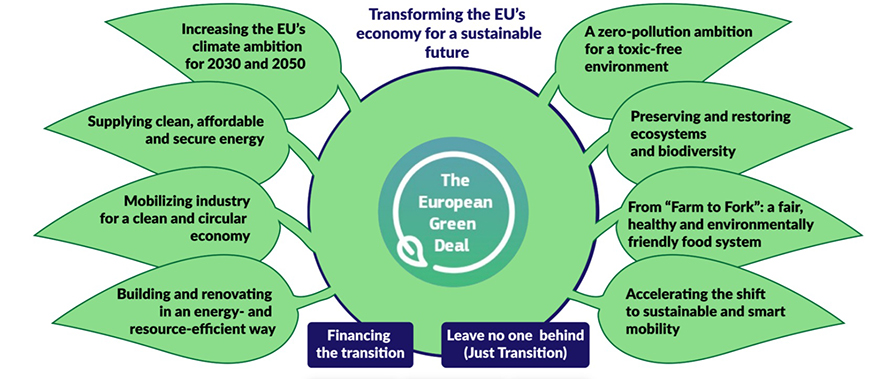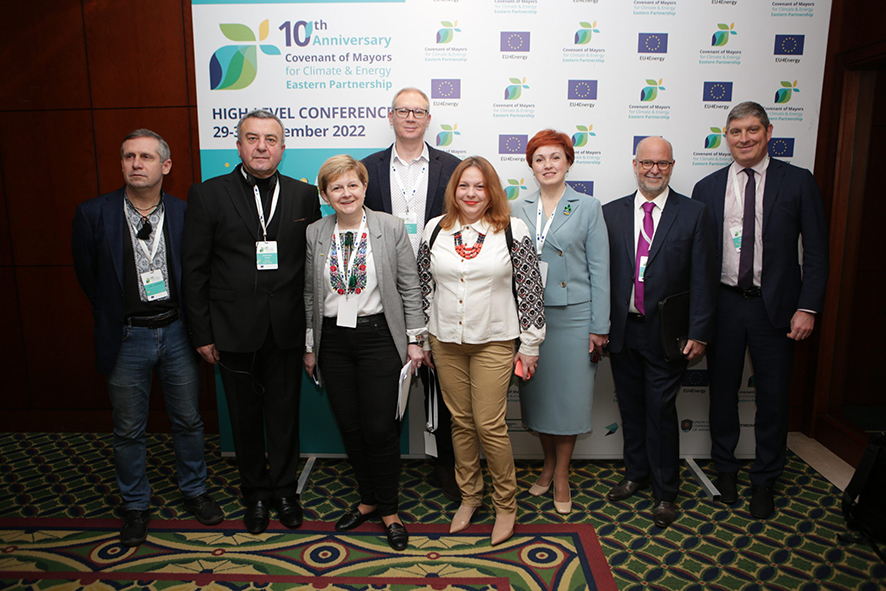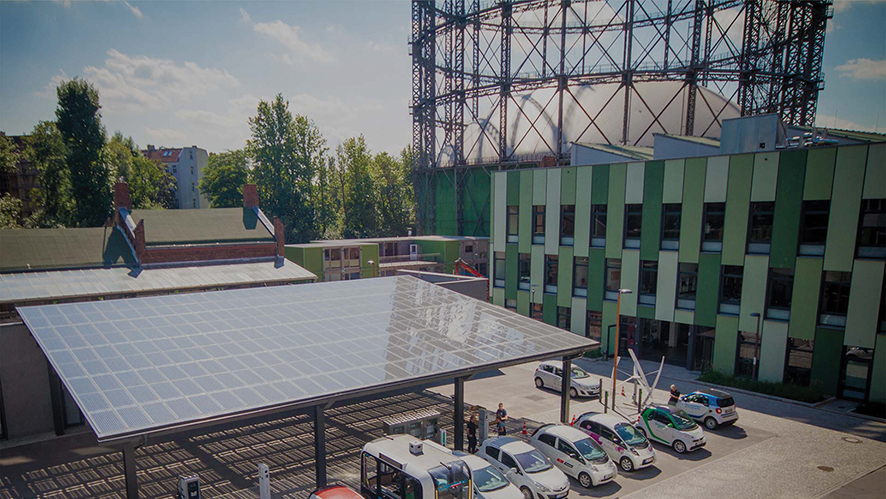This month we have discovered what we can do as individuals and business owners to make our own homes and offices more energy efficient, and some of the issues Georgia faces in terms of energy efficiency. This week, I’m going to look at what the Georgian government is doing, with its numerous foreign partners, to bring Georgia’s buildings in line with Western aspirations to go green and mitigate our negative impact on the environment.
What is Energy Efficiency?
Energy efficiency (EE) refers to the efficient use of resources so as to reduce our energy bills and operating costs, putting a decreased strain on energy infrastructure and lowering investment needs for new supply. It also refers to improving our energy security by reducing our reliance on imported or scarce energy resources, leading to a cleaner and healthier environment, lower greenhouse gas (GHG) emissions, and lessening our environmental impact. What’s more, the use of clean energy and innovative technologies ultimately leads to more public transport use over cars, more employment opportunities, and renovated and energy efficient buildings offering us healthier and more cost effective living and working spaces.
The Drivers of Energy Efficiency and Renewable Energy Source Reforms in Georgia
There are five main drivers behind Georgia’s moves to unite with the global community against climate change and energy inefficiency.
Georgia’s first green driver was the EU-Georgia Association Agreement, signed in 2014 and entering into force in 2016, through which, among other things, Georgia committed to gradually aligning its energy legislation and policies with the EU:
• Electricity and gas market liberalization
• Promotion of renewable energy and energy efficiency
• Establishment of independent energy regulatory authorities
• Compliance with EU energy efficiency and environmental standards
• Cooperation in the area of energy security and diversification of energy sources
• Implementation and Monitoring
Next came the Energy Community, which was established in 2005 to extend the EU’s internal energy market to Southeast Europe and beyond. Georgia became a member in 2017, and since has sought the Energy Community’s help, through exchanges of best practice, to create a single regulatory framework for the energy sector, monitored by the Energy Community Secretariat.
The famed and rather ambitious Paris Agreement, a global climate change accord adopted in 2015, was ratified by Georgia in 2017. Overall, the Paris Agreement aims for GHG emissions reduction by 2030 (compared to 1990) by 35% (47% from 2025) and by 50%-57% in cases of international support.
After this came the EU’s even more ambitious and far-reaching introduction of the European Green Deal, adopted in 2019, and referred to as a “man on the moon moment” by the European Commission’s President, Ursula von der Leyen. The Green Deal’s goal is to have a “global and just transition” that seeks global net-zero GHG emissions by 2050, economic growth decoupled from resource use, the development of energy efficiency and renewable energy sources, the development of sustainable and energy efficient buildings and a sustainable transport systems, the development of circular economies, the protection of biodiversity, sustainable agriculture and food systems (“from farm to fork”), zero pollution (water, air, soil), development of green finance, global digitalization, and the promotion of research and innovation. It also promises that no person and no place will be left behind.

Georgia also subscribes to the UN’s Sustainable Development Goals. Of interest here is SDG Number 7, which seeks to ensure access to affordable, reliable, sustainable, and modern energy for all, universal access to energy for all, access to electricity and clean cooking fuels and technologies for all, an increase in the share of renewable energy in the global energy mix, and an improvement in energy efficiency across different sectors, among them buildings, industry, and transportation. With this comes investment in and upgrading of energy infrastructure and clean energy technology.
It is well recognized, not least by the Government of Georgia, that achieving SDG 7 is crucial for supporting the country’s economic and social development, improving human well-being, and addressing climate change. It is closely linked to other Sustainable Development Goals, among them SDG 1 (No Poverty), SDG 3 (Good Health and Well-being), and SDG 13 (Climate Action).
Georgia’s Energy Efficiency: Buildings and Businesses
“Georgia has recently enacted regulations to boost energy efficiency in buildings, particularly targeting new constructions,” Zviad Kharebava, Director of Infrastructure and Environment at PMCG, tells GEORGIA TODAY. “Regulations set requirements for EE parameters and cover building insulation, heating, cooling, ventilation, lightings systems, etc. However, challenges persist in older privately owned buildings in cities like Tbilisi, where implementing energy-saving measures is difficult due to aging infrastructure. Efforts to innovate and improve energy efficiency in public buildings are gradually gaining traction, in public schools, kindergartens, and so on.”
“We are looking to develop the Net-Zero Consumption Buildings Strategy, which requires that all new buildings should be developed according to the technical requirements of the Law on Energy Performance of Buildings, which were introduced in 2020, though the technical annexes are still in the process of being adopted,” Giorgi Mukhigulishvili, Researcher in Energy and Climate Change Studies, tells us. “Net Zero buildings should decrease energy consumption via energy efficiency measures, but also have renewal energy integrated within them. In reality, it’s mainly related to future buildings,” he says.
He also gives us some positive news in that 50% of Georgian municipalities have so far signed the Covenant of Mayors (32 of the 64 municipalities in the country). “This requires directly that municipalities should save energy, increase the share of renewables in their energy consumption, and also decrease GHG emissions on their territories – public buildings and residential. They do so through donors providing technical and professional support to develop and implement strategies, and through twinning with cities abroad so as to share best practices,” he says.

As for the private sector, we are told that the state offers incentives to construction companies to go green.
“For example, the National Bank of Georgia developed sustainable taxonomy for the financing sector,” Mukhigulishvili tells us. “When a company decides to develop a green business, including energy efficient buildings, they will be provided with low interest loans – this encompasses both from-scratch construction and renovation of existing infrastructure. This Green Taxonomy has 11 sub-topics, including the energy performance of buildings, energy efficiency in buildings, general energy efficiency, for example in agriculture, industry and transport etc., and one of the key requirements is that it should be in line with the energy efficiency law and the performance of buildings law, as well as their technical annexes. If the businesses meet these requirements, they will be eligible for these low interest loans and support mechanisms.”
Mukhigulishvili notes that the donor’s role is vital here – the World Bank, USAID, UNDP and GIZ and others are very much involved in the process, he tells us, supporting businesses and the state in developing the above measures.
However, Georgia as yet lacks the necessary qualified and experienced auditors to check the meeting of these standards in the process of construction and renovation.
“We lack qualified professionals,” Mukhigulishvili says. “We do have a number of energy auditors for residential buildings, but we don’t have energy auditors for large-scale industrial businesses.”
He highlights that to overcome the clear challenge, the government has asked for the development of vocational education programs to grow and support energy auditors, certifiers, evaluators and other necessary specialists.
“And even more can be done,” Mukhigulishvili states. “The money is there. A key problem, which the ministry recognizes, is that we need a sustainable system to support energy efficiency and renewables development: In particular, we need to develop an independent entity to implement all the technical annexes, laws and so on. The ministry is responsible for the policy development, not the implementation. In Slovakia, for example, there is a specific energy efficiency agency, under the Ministry of Economy, which monitors and implements these measures. Georgia needs such bodies and coordination.”
The World Bank Green Report
Buildings are responsible for around 40% of energy consumption and 36% of CO2 emissions in the EU, and, while of course the numbers for Georgia will be different, they aren’t that far off: Mukhigulishvili tells us that Georgia’s residential sector consumes 30% of all energy consumption and the commercial sector 11%.
“In 2021, when the electricity price increased for the commercial sector in Georgia, we saw energy efficiency measures being applied. Last year, the World Bank released a study ‘Greening Firms in Georgia,’ the first of its kind in Georgia,” Mukhigulishvili says. “The report explores key challenges and opportunities for Georgia’s businesses to accelerate their contribution to the country’s green transition, through efficiency and reduction in emissions. GHG emissions per capita in Georgia are still below the EU average, but are growing faster than those in the EU, which poses a risk for achieving the Paris Agreement’s Nationally Determined Contributions [NDCs] and increasing the competitiveness of the Georgian economy.”
The World Bank report highlights that Georgian firms typically use energy-inefficient methods, and have increased their energy use in recent years. This, the report notes, will affect their competitiveness “as energy prices increase, the demand from consumers changes to products with greener footprints, and as new carbon trade measures are introduced in the EU and other large markets.”
“Greening the private sector is therefore a source of competitive advantage that can facilitate access to global value chains and make the economy more resilient to climate shocks and geopolitical tensions in upcoming years. If no actions are taken, industry emissions are on a path to increase by 90 percent between 2015 and 2030,” the report highlights.
“Many developed and developing countries are decoupling economic growth from GHG emissions. In Georgia, emissions are growing not only due to GDP growth but also due to the reliance on outdated technologies, poor management and organization, inefficient energy use, and weak incentives to go green because of the institutional framework and relatively low energy prices,” it adds.
Yet, the World Bank report suggests that it’s not too late to turn things around, noting that, while “there is ample room for cost-effective improvements in energy efficiency in all sectors,” since 2017, greener and more energy efficient firms, particularly new businesses and startups, have been expanding their market shares, and “even modest increases in energy efficiency among inefficient firms could reduce aggregate energy expenses and carbon emissions by 50 percent, while increasing firms’ profitability due to savings in energy costs.”

It is widely recognized that policy and private capital mobilization are key factors for positive change. Indeed, the World Bank report found that in Georgia, 8 out of 10 inefficient firms “require upgrading or expanding their fixed assets to reach the median level of efficiency,” yet “2 out of 10 could improve their efficiency without additional capital investments and might require investments in training or consulting to improve their organization and increase their efficiency.”
Also key is reliability in supply. Both Georgian business-owners and home-owners experience frequent power outages that, “combined with an underdeveloped framework for renewables,” sees more people turning to the quick and easy option of fuel generators rather than investing in the better long-term alternative of cleaner renewables.
The report notes that “relatively low electricity and gas prices discourage the adoption of clean technologies and a more efficient use of energy in production. Further, despite some progress, the institutional setting and regulatory framework do not promote a more responsible approach to the environmental impact of production,” and recommends that “in addition to structural reforms, improving energy efficiency requires firm- and sector-specific interventions that target three set of issues: (i) information and awareness, (ii) skills of managers and workers, and (iii) access to finance.”
Georgia’s Promise
Georgia’s National Climate Change Strategy 2030 and the Paris Agreement’s Nationally Determined Contributions (NDCs), outline the concrete actions the country plans to take.
In 2017, it was noted that Georgia’s share in global emissions was 0.04%, of which energy made up 60% and waste 9%. In its updated NDCs, Georgia has committed to unconditionally reducing its GHG emissions to 35% below its 1990 baseline level (an approximately 16% per capita reduction) by 2030, in doing so reiterating its strong commitment to the landmark 2015 Paris Agreement, through which world leaders agreed to take action to limit the overall temperature rise to well below 2 degrees Celsius, aiming to keep at a safe threshold of 1.5 degrees Celsius.
Georgia’s national mitigation targets today also see the country aiming to develop low-carbon approaches in the building sector, including with regard public and tourist buildings, and to promote climate-friendly, energy-efficient technologies and services.
Georgia’s strategy also supports the development of low-carbon approaches in the agricultural sector by promoting climate-smart agriculture and agro-tourism, and the development of low-carbon approaches in the waste sector. GHG emissions in the power generation and transmission sector are expected to be lowered by 15%, and a 5% cap is to be put on emissions in the industrial sector, implemented by encouraging innovative technologies and services tailored to climate goals. Further, Georgia plans to increase the carbon absorption capacity of the forestry sector by 10% by 2030 compared to the level recorded in 2015.
“The 2030 – 2050 deadlines are feasible goals for us, but only if we stay on and speed up our European integration track,” Mukhigulishvili opines.
In terms of making Georgia’s buildings more energy efficient, future steps include raising energy efficiency standards for new buildings, promoting the use of energy-efficient construction materials, and integrating renewable energy sources like rooftop solar panels.
“Georgia’s commitment to aligning its energy efficiency efforts with EU standards is evident, reflecting its broader association agreement with the European Union,” says PMCG’s Zviad Kharebava. “By harmonizing legislation with EU directives like the Energy Performance of Buildings Directive (EPBD), Georgia aims to ensure consistency in energy efficiency practices and foster sustainable development.”
In conclusion, while progress has been made, broader efforts encompassing both residential and industrial sectors are crucial for achieving significant and sustainable improvements in energy efficiency nationwide.
Key Components of Georgia’s New Climate Pledge Include:
• Unconditionally limiting its total GHGs by 35% below the 1990 level by 2030 and potentially increasing this commitment (with sufficient international support) to 50 to 57%.
• Continuing to record GHGs not regulated by the Montreal Protocol in its National GHG Inventory.
• Setting out feasible targets for limiting emissions in seven sectors (transport, buildings, energy generation and transmission, agriculture, industry, waste and forestry). This includes reducing emissions by 15% below the reference level in the transport and the energy generation and transmission sectors, by 10% in the forestry sector and by 5% in the industry sector.
• Shifting to low-carbon development approaches in the construction, waste management and agriculture sectors.
* * *
This article was inspired by the EU-funded Georgia Energy Sector Reform Program (GESRP)’s three-day media mentoring program ‘Covering Energy Efficiency and Renewable Energy Issues in Georgia’ on April 19-21, 2024, at the Tsinandali Estate, Radisson Collection Hotel.














